Friday was a very interesting day.
I had been contacted several weeks ago by a production company interested in shooting a piece about Green-Wood for an upcoming Travel Channel show. I had not heard of the show, but it sounded interesting. Friday was the date for the shoot.
I must admit, I really hadn’t done my research on the show or the host. All I knew was that they were interested in Green-Wood, which was good enough for me. When I met the crew at 9:00 a.m., it soon became apparent that this was a very professional operation. I’ve taken part in shoots before–probably about a half dozen or so, for PBS, CBS, WNYE, the Associate Press, German TV, and a few others. All of those did a great job. But this was at another level. They brought a director of photography, a producer, a sound man, and the host, Don Wildman. And they brought a second crew–a driver and two cameramen.
It turns out that Don Wildman is quite a character. He was actually a very nice, bright, articulate, and unassuming guy. He was very skilled as the host, taking over when necessary (as when I went on a bit too much; concise, concise, concise!). After the shoot, I googled Don. It turns out he studied acting in London, hosted ESPN’s “Men’s Journal” and the Travel Channel’s “Cities of the Underworld,” and is ever active: he keeps himself busy climbing mountains, paddling rivers, and racing his bike (he broke his collarbone while mountain biking down the Devil’s Staircase in Arizona for “Men’s Journal”).
When I spoke to the rep. from the production company, he requested, with the show called “Off Limits,” that we give them access to parts of Green-Wood that are not open to the public. So, I put the Catacombs and the Durant Mausoleum on the list. The rep. also asked if there was some place Don might climb at Green-Wood. I must admit, I have never gotten a request like that before. But, it turns out, Don is very big on such things. Here’s how his Facebook profile starts out: “Since he was a small boy building forts out of refrigerator boxes, Don Wildman has spent a lifetime crawling in and out of things . . . .” I suggested a climb up into our Arches. That was a go.
So we went into the Catacombs. As anyone who has gone by them knows, they are usually locked. The Catacombs date from the 1850s–this was a gravel pit in the earliest years of Green-Wood’s development. Green-Wood was founded in 1838, but the first burials did not occur until 1840. During that two year period, and in the ensuing years, roads and paths were built, the soil was improved, and lots were laid out. Green-Wood is located on a terminal moraine–where a great glacier, advancing from the north, stopped its push south about 20,000 years ago and receded back north. The hills that you see at Green-Wood were left by this glacier. The rocks along the side of the cemetery’s roads were also left by the glacier–and were recycled by the cemetery into the road beds. And, the gravel deposit that was left by the glacier was mined, then the cut where the gravel had been was turned into the Catacombs. A sort of middle class apartment house for the dead, the Catacombs offered above ground burial without the expense of building a free-standing tomb or even a hillside mausoleum.
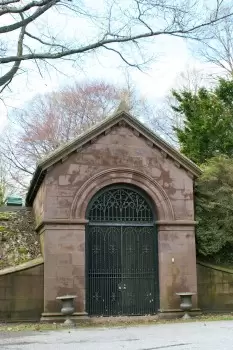
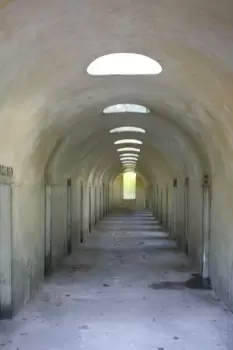
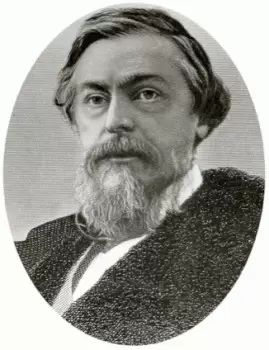
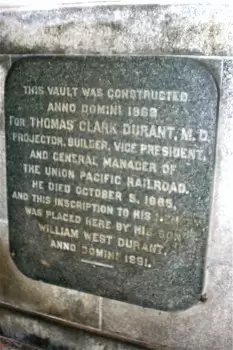
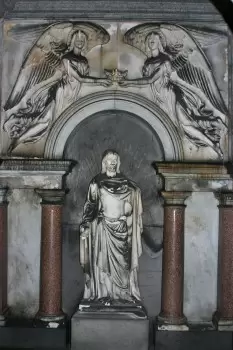
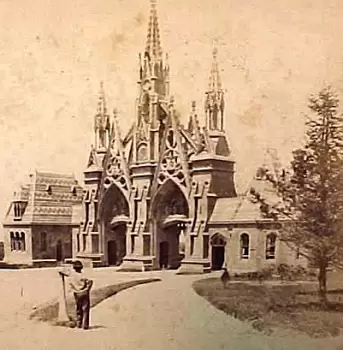
The Catacombs are known on the grounds as the 30 Vaults–fifteen on the left and fifteen on the right. Note the use of skylights to bring natural light in.
What impressed me about the crew’s work in the Catacombs was that, after the shoot, the second crew came in and shot for quite some time there.
Then it was off to the Durant Mausoleum. Thomas Durant was the prime fundraiser for the Union Pacific Railroad.
Trained as a medical doctor, he obviously had some real talent for hustling up financing. So, when the Union Pacific needed money to continue to extend its rails west, Durant would gather up investors and head out to the end of the line, in the middle of nowhere. He would hire Indians to pretend they were attacking the train, burn up thousands of acres of prairie to entertain his money men, and bring out his Irish track workers to demonstrate how fast they could lay track. He would then have a group photograph taken and pass the hat, raising enough money to pay his workers until the next fund-raising excursion. It was Durant who drove the Golden Spike in May of 1869, completing the Transcontinental Railroad by uniting the Union Pacific and the Central Pacific Railroads. But, the ceremonies were postposed because Durant was held hostage for several days by his workers, whom he had somehow forgotten to pay. Below is the great photograph of the ceremonies at Promontory Summit in the Utah Territory. You can pick out Durant, standing in the middle between the two locomotives–he was 6’4″, and towers above the others. He is the one just behind (and towering above) the man on at left center who is shaking hands in the foreground.
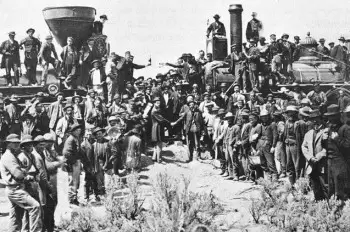
The Durant Mausoleum is quite remarkable. First of all, how about these keys, with the wonderful engraved tag, held by my favorite hand model (not George Costanza)? The iron gate and the incredible granite door are locked; only on very special occasions do we open this up. Inside is a tablet (pictured above right) describing Thomas Durant, put there in tribute by his son.
And here is some of the wonderful sculpture work by John Moffitt, the English-trained artist who completed several commissions at Green-Wood, including the reliefs on the main gates, the Ages of Man on the exterior of the Fort Hamilton Visitors’ Lounge, and the Steinway (Piano) Tomb. What is remarkable about Moffitt’s work for the Durants is that it is inside the mausoleum–where few would see it. Talk about inconspicuous consumption! Here’s the central piece–angels flying over Jesus. Great marble work. Don, it seemed, enjoyed unlocking the door and pushing against the heavy granite. I noticed quite a spider web that he dislodged as he did so–hopefully that will show up on film.
Then, as the final act, Don went up the metal ladders inside our Arch. Few people know about those ladders–they are not visible from the cemetery grounds, and are hidden behind a door. But I remembered them from my journey up them a few years ago–unquestionably the dustiest experience of my career as cemetery historian. Much of that, I am sure, is 19th century dust–the Arches, after all, were erected between 1861 and 1863. And, as you can see below, Don had quite the time up there. The crew set up a video camera and Don narrated from on high, up on the ledges of the Arches, to either side of the clock face. To give you some perspective, here’s a photograph of the Arches, circa 1865. You should be able to make out the round clock right in the middle; Don walked out on the ledge to either side of that clock.
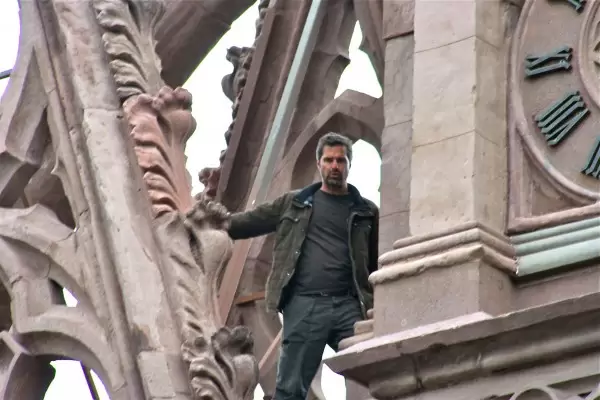
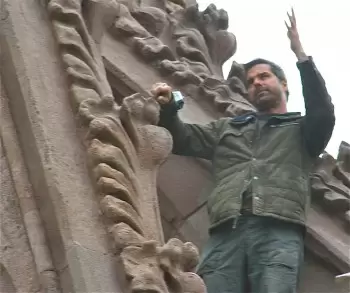
This full day’s work was for a 7 minute piece that will be part of two “Off Limits” shows on New York City that will air in the fall. Don’t miss them.
And if you’d like to see Don in an interview, when he was host of “Cities of the Underworld,” click here.